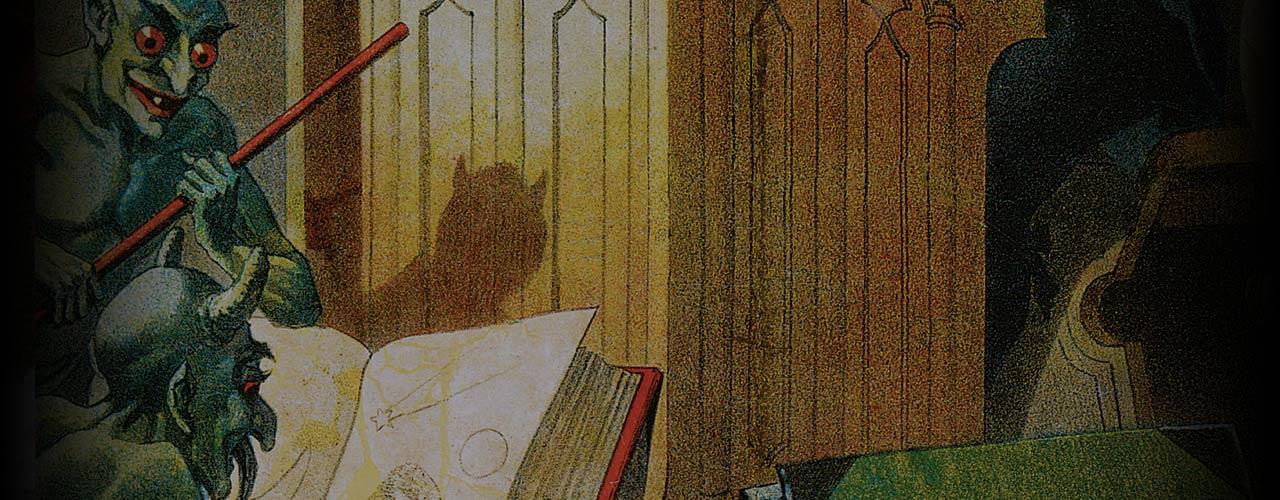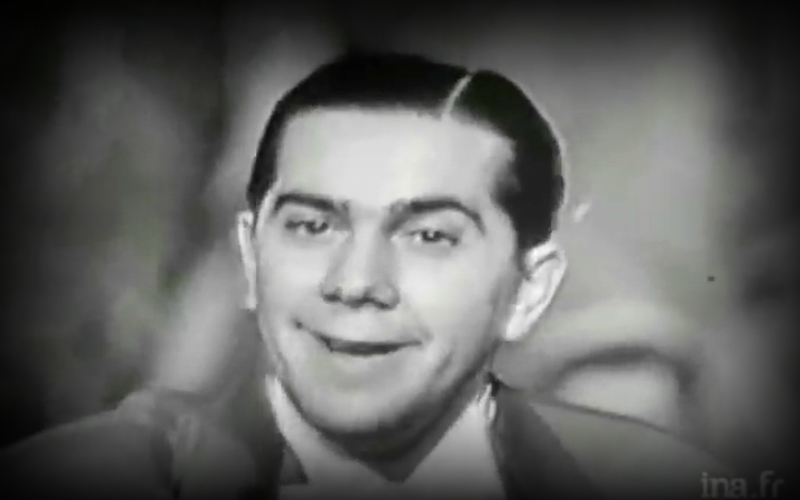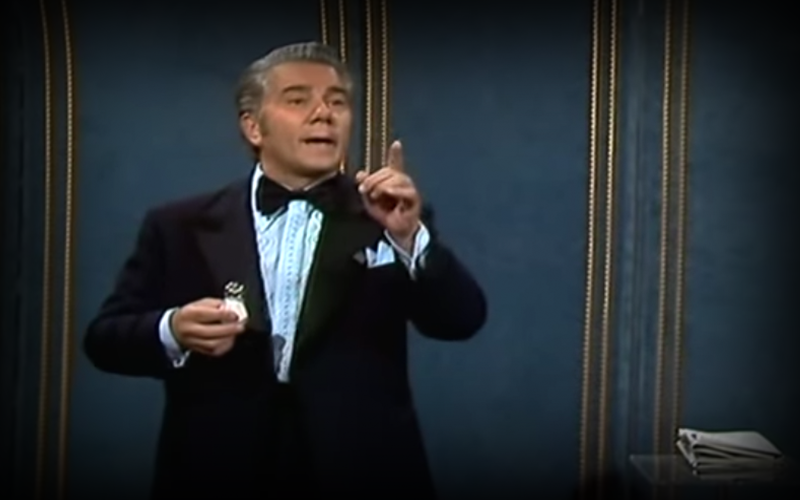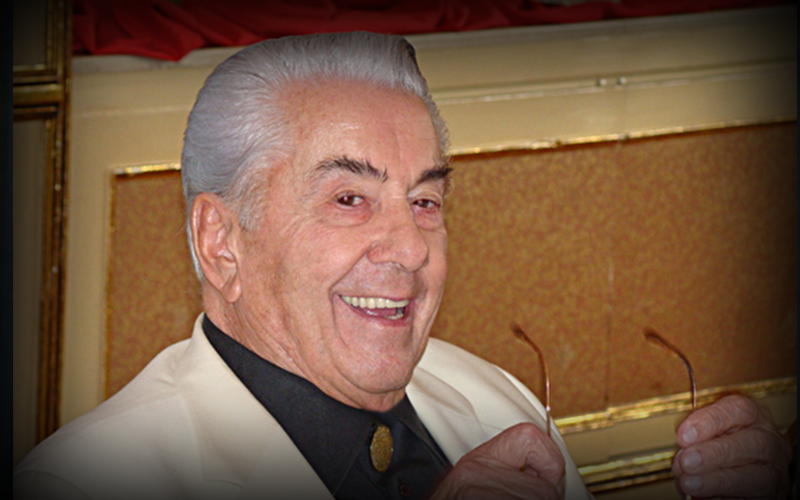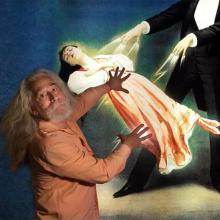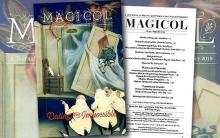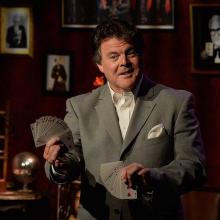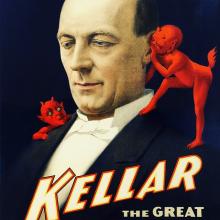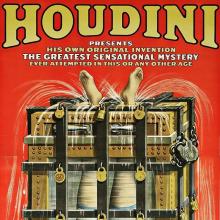Submitted by Jamy Ian Swiss on
The world of magic mourns the recent death of an accomplished star of the international world of cabaret magic, Paul Potassy, who left us in September at the age of 94. A unique talent, Potassy remains sadly unknown to many magicians on this side of the Atlantic, while being simultaneously revered by those who knew him and his work.
Born in Vienna in 1923, Potassy entered university to become an engineer, like his father before him. But the Second World War intervened and he was drafted into the German army and sent to the Russian front. In a compelling tale that he would tell for the rest of his life, Potassy would recount how his unit was overrun on the battlefield and how he tried to play dead to evade detection. But as Russian soldiers worked their way across the killing grounds, stabbing bodies with their bayonets to finish a grisly job, Potassy made himself known, begging for mercy as he shouted the word “artist” by way of identification. With a gun to his face, Potassy produced a deck of cards. Performing magic then and there, he persuaded his captors to take him prisoner instead of leaving him as another battlefield corpse.
He spent four-and-a-half years interned in a prison camp, a life spared thanks to his performing abilities, which he then employed to make life more bearable for his fellow prisoners as well as his captors. On being released in 1946, he convinced his father to allow him to pursue magic as a career instead of engineering and the rest, as the saying goes, is history—or, as the subtitle of his excellent 1997 book The Magic of Paul Potassy describes it: “How to Live Like a Millionaire with Just Six Scarves, Thirty Razor Blades and a Great Haircut!” When I reviewed the 2005 English edition in Genii (March 2006, Vol. 69, No. 3), I described it as:
…the story of a true show business veteran, the kind they don’t make anymore because they don’t do the business of show that way anymore, who earned every break he ever got, and left unforgettable wonder in his wake.
Potassy excelled at performing in the extensive cabaret market throughout Europe and Asia. He was featured on the stages of countless grand hotels and nightclubs, performing in some 44 countries in the course of his career, as well as for heads of state—and even for the Pope. “Cabaret magic” is the quintessential marketplace that demands “packs small, plays big” routines, and Potassy, an adept sleight-of-hand artist, could do everything from manipulative magic to close-up magic with little more than a pack of cards to a pickpocket act to comedy magic, anywhere in the world. How? He spoke six languages and, in a unique stylistic approach, often peppered his work with snippets of multi-language commentary and humor, thus enabling him to work as a speaking act not only in multiple countries, but also for audiences of mixed international origins. Those who are most successful in magic are those who can say “yes” to the greatest variety of opportunities—and when you can do a talking act in multiple languages, that’s a hell of a lot of yeses.
I confess I was a latecomer to the Potassy Fan Club. In 2005 I attended the Magic Circle Centenary conference in London, a densely programmed four-day convention packed with world-class magic luminaries, a genuine Who’s Who of performers. In addition to the evening stage shows, there were standout, intimate one-man shows including performances by Juan Tamariz, Tomo Maeda, and Johnny Thompson. There were also close-up shows by performers from around the world, including Tommy Wonder (Netherlands), Bob Read (UK), Tony Binarelli (Italy), and Belinda Sinclair (U.S.). But at the Sunday night Grand International Centenary Gala, the performer who was new to me and captured my attention for a riveting 20-minute turn was Paul Potassy, who was 81 at the time.
I was seated in the middle of the audience in the large theater that held the Centenary Gala show. I distinctly recall that within moments of Potassy’s taking the stage, I could instantly tell I was watching someone with thousands of shows under his belt, characterized by his ease and mastery of the stage and the crowd. He did a handful of small but potently magical signature routines, several of which you will be able to watch in the videos posted below. I was knocked out by his ability to accomplish so much with so little—his command and charisma were unforgettable.
Later, spending time backstage at one of the close-up shows with my friends Bob Read and Tommy Wonder, I spotted Potassy and introduced myself. We had a delightful conversation and I was left as charmed by the man as I had been by the performer. When I got back to New York a week or so later, I had one of my frequent lunches with my (now dearly missed) friend Charles Reynolds, a magic historian and illusion consultant to countless stage and television magic productions, including all six of Doug Henning’s groundbreaking television specials in the 1970s.
As we sat and discussed our respective experiences and thoughts about the Centenary gathering, he asked me who my favorite stage performer had been among all of the evening stage shows. I answered, “Paul Potassy.” Charles laughed, “Exactly! Me too!” Unlike me, however, Charles had long known and appreciated Potassy’s work, and we shared our mutual frustration and disappointment that so many conference attendees lauded younger and far less interesting performers for their “novel” acts, routinely overlooking a genuine master like Potassy.
In his early 80s, Potassy, along with his longtime wife and stage assistant, Lita Bueno (a native Filipino), retired from their home in Spain to spend their final years in Manila, where they continued their many sociable interests and charitable activities. From time to time, I would receive email updates about their activities, which were, upon opening, invariably a kind of fireworks display on the computer screen, alive with photos and celebrations and lively good wishes, which reflected the couple’s own joyful outlook and presence. I was lucky to know them, if only for a little bit.
We are fortunate that there are a handful of clips of Potassy in performance that have been recorded at various stages of his lengthy and illustrious career—and in multiple languages. I think these lend such delightful insight into the nature of his work that I am posting four clips in a variety of languages, because I don’t think one needs to necessarily understand what he’s saying in order to appreciate what is unfolding.
In my book review, I mentioned seeing three routines in particular at the Magic Circle Centenary show, and I commented that,
These three routines demonstrate the breadth of Mr. Potassy’s distinctive approach to magic, including the showmanship, the subtle verbal asides, the stylish touches in prop management, the relentless perfectionism and cleanliness in method, and the convincing mystery of the effects.
And here are those three—in three different languages—in three different eras of his life—for your enjoyment. I have also added a fourth clip of a routine, a personal favourite, that I also witnessed at the Centenary show. Now it’s your turn to enjoy!
The Razor Blades
Harry Houdini made the “East Indian Needle Mystery” famous and, among magicians of my generation, two masters of the trick are Teller of Penn & Teller, and Steve Spill. A later variation using razor blades is less commonly seen and, I would say, rightly so, as I think it’s rarely as compelling or believable—save for two notable exceptions in my experience: one by Richiardi, and the other by Paul Potassy. I should add that this early version by Potassy lacks a particular detail, a refinement he must have added later in his life, that fooled me badly when I witnessed it and made it all the more notable for me. (The remainder of this video features his pickpocket routine.)
French 1958
Torn & Restored Newspaper
Early in his career, Potassy hit upon the notion of using a salt shaker instead of a wand as a magical device, and it became a punctuating element of much of his work, with him even at times billing himself as “Paul Potassy and his Magic Salt.” You can see it here in his entertaining rendition of this classic plot.
GERMAN 1976
The 5000 Pesetas Bank Note
There are several recordings of Potassy performing this routine, his personalized take of the borrowed-object-in-impossible location plot. Magicians, all too often, have a tendency to overlook or leave out many of the kinds of little details that Potassy employed to raise the trick from a mere puzzle into a confounding mystery.
Spanish 1987
Paul Potassy | The Sympathetic Silks
This excerpt from Potassy’s excellent DVD set for magicians, “The Magic of Paul Potassy,” features my favorite routine that Potassy performed at the Centenary show, namely, the Sympathetic Silks. Rarely seen today, it’s a classic of the nightclub era, and like all of the routines highlighted here, a routine that packs small—requiring just six large silk kerchiefs—and plays big enough to fill a stage in front of thousands. Shot in this small studio in an instructional video for magicians, one does not get the full impact, but when I saw it live in a packed theater, it played indelibly.
(Side note to magicians: As far as I know, the only magician working today who features a version of this plot is the marvelous comedy magician and manipulator Levent, who became good friends with Potassy late in the latter’s life. That friendship and influence led Levent to market a comedy routine of his own that relies upon Potassy’s personalized version of a classic item known to many magicians, most of whom would benefit greatly from learning Potassy’s work. When Levent first shared it with me I adopted it immediately, and it never leaves my working prop case.)
ENGLISH 2006
SEE TAKE TWO INDEX

